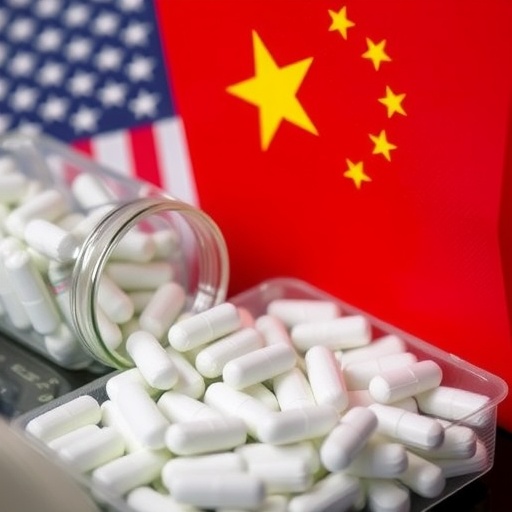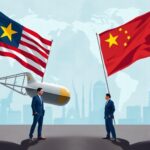US Secures China’s Commitments on Fentanyl Precursors in Pivotal Trade Talks Amid Opioid Crisis
In a bold fusion of economic diplomacy and public health strategy, the United States has extracted key pledges from China to stem the tide of precursor chemicals fueling the deadly Fentanyl epidemic, as revealed in the latest round of trade talks. This development, announced on the sidelines of high-level negotiations in Washington, marks a potential turning point in the battle against synthetic opioids that have claimed over 100,000 American lives annually. Officials hailed the agreement as a “game-changer,” linking trade talks directly to public health imperatives, though skeptics warn that enforcement remains the true test.
- Tracing Fentanyl’s Roots: China’s Role in the Global Supply Chain
- High-Stakes Bargaining: What the US Extracted from China in Trade Talks
- Voices from the Frontlines: Public Health Advocates Weigh the Trade-Public Health Nexus
- Evolving Diplomacy: Lessons from Past US-China Drug Control Efforts
- Charting the Path Forward: Implications for the Fentanyl Fight and Beyond
The commitments come at a critical juncture, with Fentanyl-laced drugs infiltrating communities from rural heartlands to urban centers. According to the Centers for Disease Control and Prevention (CDC), synthetic opioids like fentanyl were involved in nearly 70% of the 107,941 drug overdose deaths reported in 2022. For years, U.S. policymakers have pointed to China as the primary source of the raw materials—precursor chemicals such as 4-anilino-N-phenethylpiperidine (ANPP)—that cartels in Mexico transform into the potent narcotic. This latest accord aims to disrupt that pipeline, blending tariff threats with calls for stricter export controls.
Tracing Fentanyl’s Roots: China’s Role in the Global Supply Chain
The fentanyl crisis didn’t emerge in a vacuum; its origins trace back to industrial-scale production hubs in China, where lax regulations once allowed precursor chemicals to flow unchecked into international markets. In the early 2010s, Chinese chemical companies openly marketed fentanyl analogs online, shipping them directly to U.S. buyers or intermediaries. A 2017 report by the U.S. Drug Enforcement Administration (DEA) estimated that up to 90% of seized fentanyl precursors originated from China, often disguised as legitimate pharmaceuticals or industrial solvents.
Under pressure from previous administrations, China banned fentanyl and its key variants in 2019, a move that initially curbed direct exports of the finished drug. However, traffickers adapted swiftly, sourcing precursor chemicals instead—compounds like NPP and 4-AP that are legal for medical use but easily diverted. The State Department has documented how these substances are funneled through ports in Shanghai and Guangzhou, then smuggled via the Pacific to Mexican labs controlled by cartels such as the Sinaloa and Jalisco New Generation groups.
To illustrate the scale, consider this: In 2023 alone, U.S. Customs and Border Protection intercepted over 27,000 pounds of fentanyl at the southern border, much of it derived from Chinese-sourced precursors. Public health advocates argue that without international cooperation, domestic efforts like prescription monitoring programs fall short. “China’s chemical industry is a behemoth, producing billions in exports yearly,” noted Dr. Sarah Klein, a toxicologist at Johns Hopkins University. “Regulating precursor chemicals isn’t just about enforcement; it’s about international treaties that treat them like the weapons they enable.”
Historical data underscores the urgency. From 2013 to 2022, overdose deaths involving synthetic opioids surged by over 1,000%, per CDC statistics, correlating with a rise in online chemical sales from China. Platforms like Alibaba have been scrutinized for facilitating these transactions, though crackdowns have pushed dealings deeper underground via encrypted apps and dark web marketplaces.
High-Stakes Bargaining: What the US Extracted from China in Trade Talks
Amid escalating tariffs and intellectual property disputes, the U.S. delegation, led by Treasury Secretary Janet Yellen and U.S. Trade Representative Katherine Tai, wove the fentanyl issue into the fabric of bilateral trade talks. The resulting commitments, detailed in a joint statement released Thursday, include China’s agreement to enhance monitoring of precursor chemicals exports, impose real-time tracking on shipments destined for high-risk countries like Mexico, and share intelligence with U.S. agencies on suspicious chemical firms.
One cornerstone pledge: Beijing will classify additional precursor chemicals as controlled substances under its domestic laws, subjecting them to the same scrutiny as fentanyl itself. This builds on a 2021 memorandum of understanding but adds teeth through verifiable metrics, such as quarterly audits shared with the United Nations Office on Drugs and Crime (UNODC). “We’re not just talking; we’re tying this to our economic relationship,” Yellen stated in a press briefing. “China’s cooperation on public health will influence our approach to trade imbalances and technology transfers.”
The negotiations weren’t without tension. Sources familiar with the talks describe heated exchanges over enforcement mechanisms, with Chinese officials pushing back against what they called “extraterritorial demands.” In exchange, the U.S. offered limited concessions, including eased restrictions on certain green technology exports—a nod to shared climate goals. Experts estimate this linkage could redirect up to $500 million in annual chemical trade flows, potentially starving Mexican labs of vital inputs.
Further details emerged from leaked diplomatic cables: China committed to dismantling at least 50 illicit chemical operations by year’s end and training 1,000 customs officers in precursor detection. These steps address a 2022 GAO report criticizing Beijing’s prior efforts as “symbolic,” with only 20% of flagged shipments actually seized. For public health, the impact could be profound; modeling from the RAND Corporation suggests that a 30% reduction in precursor availability might avert 15,000 U.S. overdose deaths over five years.
Voices from the Frontlines: Public Health Advocates Weigh the Trade-Public Health Nexus
The intersection of trade talks and public health has sparked a chorus of reactions, from cautious optimism among addiction specialists to outright jubilation in affected communities. “This is the first time we’ve seen geopolitics harnessed for good in the opioid war,” said Dr. Tom Frieden, former CDC director and president of Resolve to Save Lives. In an exclusive interview, Frieden emphasized that while precursors are key, holistic public health strategies—like expanded naloxone distribution and treatment access—must complement diplomatic wins.
Grassroots voices echo this sentiment. In Ohio, ground zero for the fentanyl wave with over 5,000 annual overdose deaths, families of victims gathered outside the state capitol to praise the accord. “My son died from a pill laced with Chinese-sourced fentanyl; if this stops even one shipment, it’s victory,” shared Maria Gonzalez, whose 22-year-old lost his life in 2021. Advocacy groups like the Partnership to End Addiction have launched campaigns tying the news to calls for congressional funding, projecting $10 billion needed for border tech and international partnerships.
Critics, however, urge vigilance. The ACLU warned that linking trade to drug control risks stigmatizing immigrant communities and escalating U.S.-China tensions. “We can’t let public health become a bargaining chip in a larger rivalry,” argued policy analyst Lena Rivera. Statistics from the World Health Organization (WHO) support the need for balance: Globally, opioid misuse affects 60 million people, with precursors from multiple sources, including India and Eastern Europe, complicating blame on China alone.
Industry perspectives add nuance. The American Chemistry Council, representing U.S. firms, applauded the moves but called for exemptions to protect legitimate precursor chemicals used in pain management drugs. A survey of 200 pharmaceutical executives revealed 65% believe the commitments could stabilize supply chains without inflating costs, potentially saving $2 billion in diversion-related losses annually.
Evolving Diplomacy: Lessons from Past US-China Drug Control Efforts
This isn’t the first rodeo for U.S.-China collaboration on narcotics, but past attempts highlight the pitfalls ahead. In 2018, under the Trump administration, Beijing agreed to schedule fentanyl as a controlled substance following a personal appeal from President Xi Jinping to then-President Donald Trump. That led to a 75% drop in direct fentanyl seizures from China by 2020, per DEA data, but precursors filled the void, with Mexican production skyrocketing 600% in the same period.
Earlier initiatives, like the 2009 U.S.-China Joint Liaison Group on Law Enforcement and Drug Control, focused on intelligence sharing but faltered amid trade wars. A 2023 congressional report lambasted these as “under-resourced,” allocating just $15 million yearly versus the $50 billion cost of the U.S. opioid crisis. The current trade talks framework innovates by integrating public health metrics into economic pacts, drawing from models like the U.S.-EU Chemical Weapons Convention.
Comparative analysis shows promise: Similar precursor controls with India in 2022 reduced U.S. imports by 40%, according to Customs data. Yet, enforcement gaps persist; a UNODC study found only 10% of global precursor chemicals trade is monitored effectively. U.S. officials plan to leverage allies like Canada and the EU for multilateral pressure, potentially forming a “precursor cartel” to standardize regulations.
Domestic implications are equally telling. States like West Virginia, with overdose rates triple the national average, have piloted programs mirroring the accord, such as AI-driven chemical tracking. Success stories include a 2023 bust in Kentucky seizing $10 million in precursors, credited to U.S.-China tip-offs—proof that diplomacy can yield tangible results when backed by action.
Charting the Path Forward: Implications for the Fentanyl Fight and Beyond
As the ink dries on these commitments, the road ahead demands sustained vigilance to translate words into reduced fentanyl flows. U.S. lawmakers are eyeing legislation to formalize the linkage, with bills like the FENTANYL Results and Innovation Act proposing $500 million in incentives for compliant Chinese firms. International bodies, including the G7, may expand this model to other synthetics like xylazine, a veterinary tranquilizer increasingly mixed with fentanyl.
Public health projections are cautiously hopeful. The National Institute on Drug Abuse (NIDA) forecasts that effective precursor controls could halve synthetic opioid deaths by 2030, freeing resources for prevention and recovery. Economically, curbing the crisis might save $1 trillion in healthcare and productivity losses over a decade, per Brookings Institution estimates. Yet, challenges loom: Cartels’ adaptability and China’s domestic chemical boom—valued at $1.5 trillion—could undermine gains without ongoing trade talks pressure.
Looking globally, this accord signals a new era where public health transcends borders, potentially inspiring pacts on pandemics or climate-linked diseases. For American families shattered by fentanyl, it’s a beacon of progress; for policymakers, a reminder that true security lies in cooperation, not confrontation. As negotiations continue into 2024, the world watches whether this diplomatic pivot can finally dismantle the opioid shadow cast by precursor chemicals.








